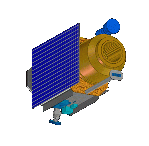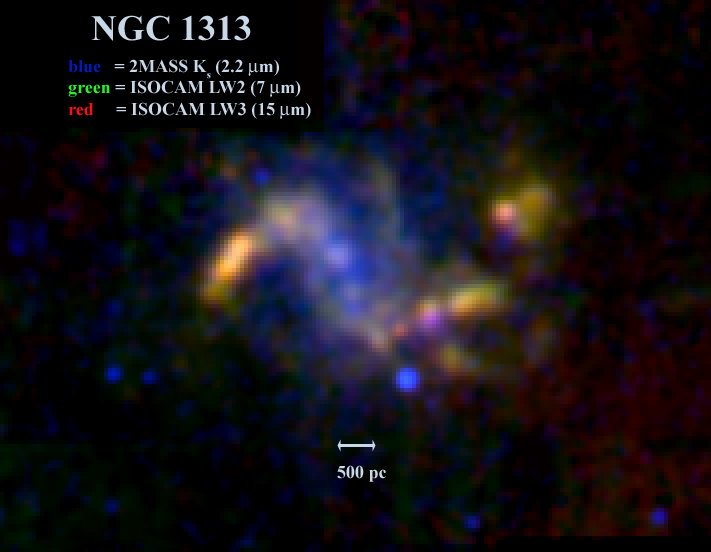
Nearby Galaxies
Next Generation Sky Survey
T. Jarrett (IPAC)
April 18, 2000
updated Aug 9, 2001

|
Nearby Galaxies
T. Jarrett (IPAC)
|
The angular resolution of NGSS allows detailed study of the internal structure of galaxies in the local Universe. There are over 3000 galaxies within 20 Mpc of the Sun, providing a statistically significant sample to study all morphological types, including the Hubble sequence (elipticals, early, late and barred-type spirals), irregular and peculiar, compact and dwarf, radio, Seyfert and interacting galaxies. The mid-infrared bands of NGSS are an effective probe of the underlying stellar population and sites of star-formation in galaxies.
 The NGSS survey of nearby galaxies will form a
complimentary dataset to the SIRTF Nearby Galaxy
Survey Legacy project, expanding their sample of 75
galaxies to many thousands of galaxies, spanning the
widest range in morphological type. NGSS will provide
the crucial mid-IR information of the SED for large
sample multi-wavelength galaxy surveys, spanning the
UV (UIT,GALEX), optical (DPOSS,SDSS),
near-infrared (2MASS), far-infrared (IRAS, ISO,
SIRTF) and the radio (NVSS, FIRST).
The figure of NGC 1313 illustrates
the power of combining the near and mid-infrared
bands. NGC 1313 is a nearby barred-spiral (SBd) whose underlying older stellar population is traced by
the 2MASS Ks band (blue tones), and the sites of star-formation (via hot dust and PAH emission) are
revealed in the mid-infrared ISOCAM images (green and red tones). The surface brightness (5-sigma)
limit for 2MASS is ~35 uJy/arcsec^2, comparable with that of NGSS. The angular resolution is 9",
where 2MASS has been degraded to match the ISOCAM data. NGSS will have ~2 times better
resolution than ISOCAM, comparable with 2MASS, allowing delination of the individual sites of star
formation and resolving large-scale structures.
The NGSS survey of nearby galaxies will form a
complimentary dataset to the SIRTF Nearby Galaxy
Survey Legacy project, expanding their sample of 75
galaxies to many thousands of galaxies, spanning the
widest range in morphological type. NGSS will provide
the crucial mid-IR information of the SED for large
sample multi-wavelength galaxy surveys, spanning the
UV (UIT,GALEX), optical (DPOSS,SDSS),
near-infrared (2MASS), far-infrared (IRAS, ISO,
SIRTF) and the radio (NVSS, FIRST).
The figure of NGC 1313 illustrates
the power of combining the near and mid-infrared
bands. NGC 1313 is a nearby barred-spiral (SBd) whose underlying older stellar population is traced by
the 2MASS Ks band (blue tones), and the sites of star-formation (via hot dust and PAH emission) are
revealed in the mid-infrared ISOCAM images (green and red tones). The surface brightness (5-sigma)
limit for 2MASS is ~35 uJy/arcsec^2, comparable with that of NGSS. The angular resolution is 9",
where 2MASS has been degraded to match the ISOCAM data. NGSS will have ~2 times better
resolution than ISOCAM, comparable with 2MASS, allowing delination of the individual sites of star
formation and resolving large-scale structures.
Point 2: Sensitivity is important, of course, but the critical component for studying nearby galaxies is angular resolution. The most important constituents of spiral galaxies, for example, are GMCs and star formation regions. Both entities have size scales near the angular resolution limit of most surveys (the exception being HST, which has super-resolution), including NGSS. Improved resolution also effectively increases the sensitivity by decreasing the confusion noise (from the galaxy itself). Hence, this argues for maximizing the NGSS angular resolution: redundancy and optimal dithering lead toward improved image reconstruction (via PSF deconvolution).
For spheroidals and elliptical types, the L and M bands trace the dominant stellar populations, providing a more effective measure of the halo/bulge populations and the overall mass-to-light ratio. IRAS showed that gas and dust are not "globally" common in these types of galaxies; however, the resolution of IRAS limits the detailed understanding of any current star formation that may be present. The NGSS MIR bands provide the necessary sensitivity and resolution to expose any compact star-formation regions in these galaxies. If they exist, hot dust and PAH emission features are seen as a second component (or infrared excess) in the NIR-MIR SED characterized by the R-J blackbody from the old stellar population. Lenticular galaxies are a particularly promising laboratory to study the possible transition between star-forming disk galaxies and (mostly?) dust-free elliptical galaxies.
For spirals and starburst galaxies, the 12 and 24 micron bands provide a sharp probe to the underlying (dust-enshrouded) star-formation. The origin of the 12 and 24-micron emission is associated with continuum emission from small, hot dust grains and strong line emission bands associated with PAHs. The grains are transiently heated by the interstellar radiation field, primarily derived from young hot stars, but also driven by older main-sequence stars. The emission bands are associated with star-formation, with the strongest bands (relative to the continuum) occurring for star-formation "quiescent" galaxies, and the weakest (or non-existent) bands for the most powerful star formation regions. As the continuum rises with heating intensity, the PAHs are probably being destroyed, resulting in weaker PAH bands. Hence, the MIR can be used as a direct gauge of the level of star-formation in spiral and active (gas-rich) galaxies (e.g., Helou 1999; Dale et al. 1999; Elbaz et al. 1999; Boiselli et al. 1998).
 The NGSS survey of nearby galaxies will form a
complimentary dataset to the SIRTF Nearby Galaxy Survey
Legacy project, expanding their sample of 75 galaxies to many thousands
of galaxies, spanning the widest range in morphological type. NGSS
will provide the crucial mid-IR information of the SED for large sample
multi-wavelength galaxy surveys, spanning the UV (e.g., GALEX), optical
(DPOSS And the SDSS), near-infrared (2MASS), far-infrared (IRAS, ISO, SIRTF)
and the radio (NVSS, FIRST).
The surface brightness sensitivity,
resolution
and all-sky
nature of NGSS are naturally matched with that of 2MASS,
allowing direct
comparison between the near and mid-infrared bands. The figure of
NGC 1313
illustrates the power of combining the near and mid-infrared bands.
NGC 1313 is a nearby barred-spiral (SBd) whose underlying older stellar
population is traced by the 2MASS Ks band (blue tones), and the
sites of star-formation (via hot dust and PAH emission)
are revealed in the mid-infrared ISOCAM images (green and red tones).
The surface brightness (5-sigma) limit for 2MASS is
~35 uJy/arcsec^2, comparable with that of NGSS.
The angular resolution is 9", where 2MASS has been degraded to match
the ISOCAM data. NGSS will have ~2 times better resolution than
ISOCAM, comparable with 2MASS, allowing delination of the individual sites of star formation
and resolving large-scale structures.
The NGSS survey of nearby galaxies will form a
complimentary dataset to the SIRTF Nearby Galaxy Survey
Legacy project, expanding their sample of 75 galaxies to many thousands
of galaxies, spanning the widest range in morphological type. NGSS
will provide the crucial mid-IR information of the SED for large sample
multi-wavelength galaxy surveys, spanning the UV (e.g., GALEX), optical
(DPOSS And the SDSS), near-infrared (2MASS), far-infrared (IRAS, ISO, SIRTF)
and the radio (NVSS, FIRST).
The surface brightness sensitivity,
resolution
and all-sky
nature of NGSS are naturally matched with that of 2MASS,
allowing direct
comparison between the near and mid-infrared bands. The figure of
NGC 1313
illustrates the power of combining the near and mid-infrared bands.
NGC 1313 is a nearby barred-spiral (SBd) whose underlying older stellar
population is traced by the 2MASS Ks band (blue tones), and the
sites of star-formation (via hot dust and PAH emission)
are revealed in the mid-infrared ISOCAM images (green and red tones).
The surface brightness (5-sigma) limit for 2MASS is
~35 uJy/arcsec^2, comparable with that of NGSS.
The angular resolution is 9", where 2MASS has been degraded to match
the ISOCAM data. NGSS will have ~2 times better resolution than
ISOCAM, comparable with 2MASS, allowing delination of the individual sites of star formation
and resolving large-scale structures.
END
Origin of the near and mid-infrared emission
The IRAS 12-micron band first revealed the existence of hot dust grains in the ISM of the Milky Way and in other galaxies. But it was ISO that allowed both the spatial and spectral resolution needed to fully reveal the nature of the mid-infrared (MIR), 4 to 15-micron, radiation. The spectral energy distribution for a normal spiral galaxy, for example, is dominated by continuum emission from small, hot dust grains and strong line emission bands associated with PAHs. The grains are transiently heated by the interstellar radiation field, primarily derived from young hot stars, but also driven by older main-sequence stars. The emission bands are associated with star-formation, with the strongest bands (relative to the continuum) occurring for star-formation "quiescent" galaxies, and the weakest (or non-existent) bands for the most powerful star formation regions. As the continuum rises with heating intensity, the PAHs are probably being destroyed, resulting in weaker PAH bands. ISO has thus shown that the MIR can be used as a direct gauge of the level of star-formation in spiral and active (gas-rich) galaxies (e.g., Helou 1999; Dale et al. 1999; Elbaz et al. 1999; Boiselli et al. 1998). For elliptical (and gas poor) galaxies, the MIR is instead dominated by the Rayleigh-Jeans tail of the cold stellar component.
The sensitivity and spatial resolution of the IRAC bands (3.6, 4.5, 5.8 and 8.0-microns) provide a sharp probe to the underlying (dust-enshrouded) star-formation in nearby galaxies. Individual GMCs, star-formation regions, and morphological "bar" features can be studied in detail with the super-resolution IRAC images in conjunction with optimized PIXON deconstruction. In combination with 2MASS 1-2-micron (NIR) imaging, variations in dust column density can be mapped with exquisite detail, delineating bars, individual GMCs and compact HII regions. The IRAC "PAH- emission bands" at 5.8 and 8.0-microns, compared with the IRAC "continuum bands" at 3.6 and 4.5-microns, indicate the star-formation intensity level. Moreover, colors derived from the IRAC and MIPS bands (in particular, 8.0 vs. 24-microns) provide the highest resolution indicator of embedded star formation at size scales comparable to GMCs.
For gas poor galaxies (including elliptical, S0 and some dwarf galaxies) the NIR-MIR directly traces the dominant stellar populations, providing a more effective measure of the halo/bulge populations and the overall mass-to-light ratio. IRAS showed that gas and dust are not "globally" common in these types of galaxies; however, the resolution of IRAS limits the detailed understanding of any current star formation that may be present. The SIRTF MIR bands provide the necessary sensitivity and resolution to expose any compact star-formation regions in these galaxies. If they exist, hot dust and PAH emission features are seen as a second component (or infrared excess) in the NIR-MIR SED characterized by the R-J blackbody from the old stellar population. Lenticular galaxies are a particularly promising laboratory to study the possible transition between star-forming disk galaxies and (mostly?) dust-free elliptical galaxies.
Provocative Images: NIR + MIR
blue = 2MASS Ks (2.2 microns)
green = ISOCAM LW2 (5.5 - 8.5 microns)
red = ISOCAM LW3 (12.2 - 17 microns)
blue = 2MASS Ks (2.2 microns)
green = ISOCAM LW2 (5.5 - 8.5 microns)
red = ISOCAM LW3 (12.2 - 17 microns)
blue = 2MASS Ks (2.2 microns)
green = ISOCAM LW8 (10.9 - 11.9 microns)
red = ISOCAM LW3 (12.2 - 17 microns)
blue = 2MASS J (1.2 microns)
green = 2MASS Ks (2.2 microns)
red = ISOCAM LW2 (5.5 - 8.5 microns)
blue = 2MASS J (1.2 microns)
green = 2MASS Ks (2.2 microns)
red = ISOCAM LW2 (5.5 - 8.5 microns)
** Thanks to Alessandra Contursi for providing the
outstanding ISOcam mosaic images **
Reference
see also the
M82 spectrum from the
SINGS Legacy